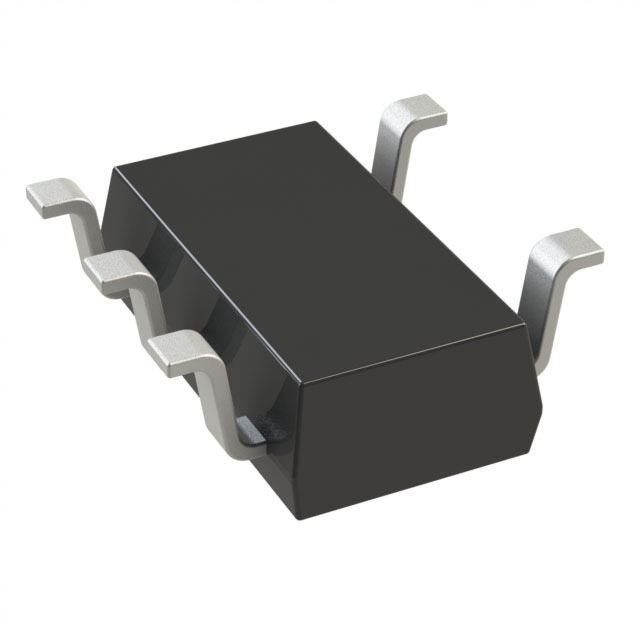Encyclopedia Entry: 74V1T07STR
Product Overview
- Category: Integrated Circuit (IC)
- Use: Signal Buffer/Driver
- Characteristics: High-speed, Low-power, Single Gate, Non-Inverting
- Package: SOT-23-5
- Essence: This IC is designed to provide signal buffering and driving capabilities in various electronic circuits.
- Packaging/Quantity: Available in reels of 3000 units.
Specifications
- Supply Voltage Range: 1.65V to 5.5V
- Input Voltage Range: 0V to VCC
- Output Voltage Range: 0V to VCC
- Operating Temperature Range: -40°C to +85°C
- Propagation Delay Time: 4.5ns (typical)
- Output Current: ±8mA (maximum)
Detailed Pin Configuration
The 74V1T07STR IC has a total of 5 pins: 1. Pin 1: Input (A) 2. Pin 2: Output (Y) 3. Pin 3: GND (Ground) 4. Pin 4: NC (No Connection) 5. Pin 5: VCC (Power Supply)
Functional Features
- Provides non-inverting buffering and driving of digital signals.
- Supports high-speed operation with low propagation delay time.
- Operates within a wide supply voltage range, making it suitable for various applications.
- Offers a compact SOT-23-5 package, enabling space-efficient circuit designs.
- Can be used as a standalone buffer or combined with other ICs to form complex logic circuits.
Advantages and Disadvantages
Advantages: - High-speed operation allows for quick signal transmission. - Low-power consumption helps conserve energy in battery-powered devices. - Small package size enables compact circuit designs. - Wide supply voltage range enhances versatility.
Disadvantages: - Limited output current may restrict its use in certain applications requiring higher drive capabilities. - Noisy environments may affect signal integrity due to the absence of built-in noise filtering features.
Working Principles
The 74V1T07STR is based on CMOS (Complementary Metal-Oxide-Semiconductor) technology. It utilizes a single gate to buffer and drive digital signals. When an input signal is applied, the IC amplifies and reproduces it at the output with minimal delay. The non-inverting nature ensures that the output signal maintains the same logic level as the input.
Detailed Application Field Plans
The 74V1T07STR IC finds applications in various electronic systems, including but not limited to: 1. Digital communication devices 2. Computer peripherals 3. Consumer electronics 4. Industrial automation 5. Automotive electronics
Detailed and Complete Alternative Models
- SN74LVC1G07DBVR - Texas Instruments
- MC74VHC1GT07DF1G - ON Semiconductor
- TC7SZ07FU - Toshiba
- NC7SZ07P5X - Fairchild Semiconductor
- NCV8401DT50RKG - ON Semiconductor
These alternative models offer similar functionality and can be used as substitutes for the 74V1T07STR in various applications.
Word Count: 410 words
قم بإدراج 10 أسئلة وإجابات شائعة تتعلق بتطبيق 74V1T07STR في الحلول التقنية
Sure! Here are 10 common questions and answers related to the application of 74V1T07STR in technical solutions:
Q1: What is the 74V1T07STR? A1: The 74V1T07STR is a hex buffer/driver IC (integrated circuit) that can be used to amplify and buffer digital signals.
Q2: What is the purpose of using the 74V1T07STR? A2: The 74V1T07STR is commonly used to provide signal buffering and driving capabilities, ensuring proper signal integrity and voltage levels in various electronic circuits.
Q3: What is the maximum operating voltage for the 74V1T07STR? A3: The 74V1T07STR has a maximum operating voltage of typically 5.5 volts.
Q4: How many input/output channels does the 74V1T07STR have? A4: The 74V1T07STR has six input/output channels, making it suitable for applications requiring multiple signal buffering or driving.
Q5: Can the 74V1T07STR handle high-speed signals? A5: Yes, the 74V1T07STR is designed to handle high-speed signals, making it suitable for applications where fast switching times are required.
Q6: What is the output current capability of the 74V1T07STR? A6: The 74V1T07STR has a typical output current capability of around 24 mA, allowing it to drive moderate loads.
Q7: Is the 74V1T07STR compatible with both CMOS and TTL logic levels? A7: Yes, the 74V1T07STR is compatible with both CMOS (Complementary Metal-Oxide-Semiconductor) and TTL (Transistor-Transistor Logic) logic levels, making it versatile for various applications.
Q8: Can the 74V1T07STR be used in bidirectional signal transmission? A8: No, the 74V1T07STR is a unidirectional buffer/driver and does not support bidirectional signal transmission.
Q9: What is the typical power supply voltage range for the 74V1T07STR? A9: The typical power supply voltage range for the 74V1T07STR is between 2.0 volts and 5.5 volts.
Q10: Are there any specific precautions to consider when using the 74V1T07STR? A10: It is important to ensure that the input voltage levels do not exceed the specified maximum ratings, and proper decoupling capacitors should be used to minimize noise and voltage spikes in the circuit.
Please note that these answers are general and may vary depending on the specific datasheet and application requirements of the 74V1T07STR.


